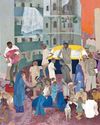Anshu Gupta’s Goonj has created a new paradigm of giving, transforming lives in villages across India.

IN THE EARLY ’90s, Anshu Gupta, then a young freelance journalist, used to roam the streets of Delhi in search of stories of people who remained invisible. This is when he met Habib bhai, a middle-aged man who lived on the pavement outside Delhi’s LNJP Hospital and delivered unclaimed dead bodies to the police. His cart was a moving advertisement for his work—‘laawaris laash uthaane wala’ scribbled on it. Habib bhai got paid `2 and some cloth for every dead body he handed over to the police. The winter months were busy, Habib bhai had said matter-of-factly. After all, many more homeless people died in the bitter Delhi cold— sometimes up to 10 to 12 a day.
Gupta followed him around for a whole week to understand what it meant to be a bearer of unclaimed corpses. His middle-class notions about the boundaries of what was human were shaken, but not shattered— until he met six-year-old Bano, Habib bhai’s daughter. “When it gets too cold, I go to sleep hugging dead bodies,” she had said with a bland expression. “It keeps me warm, and the best part is, dead people do not move—you get to sleep peacefully.”
Trained to be a journalist, Gupta never quite forgot what he saw and heard during his week with Habib bhai—the heart-wrenching struggles of the dispossessed for daily survival. It was often not the cold but the inadequate clothing that triggered the needless loss of lives.
この記事は Reader's Digest India の February 2019 版に掲載されています。
7 日間の Magzter GOLD 無料トライアルを開始して、何千もの厳選されたプレミアム ストーリー、9,000 以上の雑誌や新聞にアクセスしてください。
すでに購読者です ? サインイン
この記事は Reader's Digest India の February 2019 版に掲載されています。
7 日間の Magzter GOLD 無料トライアルを開始して、何千もの厳選されたプレミアム ストーリー、9,000 以上の雑誌や新聞にアクセスしてください。
すでに購読者です? サインイン

BOOKS
Books review

STUDIO - Off Lamington Road by Gieve Patel
Oil on Canvas, 54 x 88 in

NEWS FROM THE WORLD OF MEDICINE
FOODS THAT FIGHT DEMENTIA

TO HELL AND BACK
The Darvaza crater in Turkmenistan is known as the Gates of Hell. I stood on its edge - and lived to tell the tale

THE SNAKE CHARMERS
Invasive Burmese pythons are squeezing the life out of Florida's vast Everglades. An unlikely sisterhood is taking them on

Sisterhood to Last a Lifetime
These college pals teach a master class in how to maintain a friendship for 50-plus years

...TO DIE ON A HOCKEY RINK
ONE MINUTE I WAS PLAYING IN MY BEER LEAGUE, THE NEXT I WAS IN THE HOSPITAL

Just Sit Tight
Broken, battered and trapped in a ravine for days, I desperate driver wonders, \"Will anyone find me?\"

Allow Me to Mansplain...
If there's one thing we know, it's this: We're a nation of know-it-alls

THE BITTER TRUTH ABOUT SUGAR (AND SUGAR SUBSTITUTES!)
It's no secret that we have a serious addiction. Here's how to cut back on the sweet stuff, once and for all.